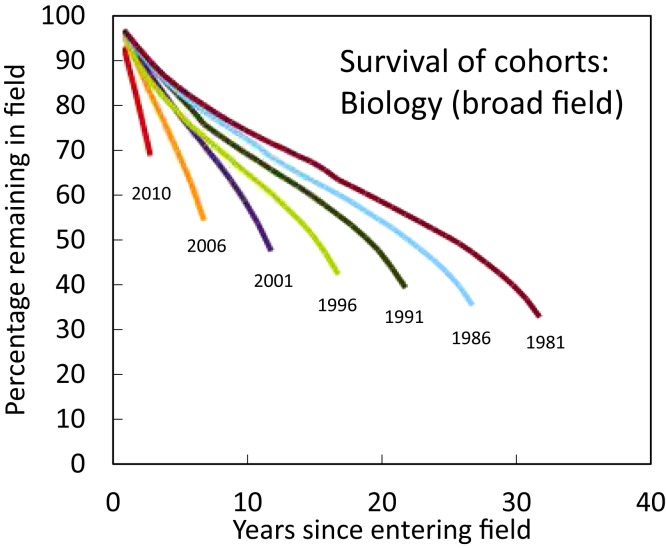We thank Hanlon for his comments on our paper and appreciate his summary of our findings (1). We recognize the concerns raised regarding both research and non-research roles in science. For example, the National Science Foundation reports various estimates of the science labor force: about 6 million in “science and engineering [S&E] occupations,” about 12 million in non-S&E occupations closely or somewhat related to their S&E degree, about 17 million whose highest degree is in S&E, and about 23 million with at least 1 S&E degree (2).
Given our interest in the relationship between the changing landscape of knowledge production and scientific careers, we opted for what Xie and Shauman (3) call the “substantive” definition of a scientist, according to which “one’s contribution to a common body of scientific knowledge and thus one’s involvement in scientific [journal] communication” is used as the ultimate criterion to determine whether one should be considered a scientist. This definition is not limited to those in universities but also includes those in any occupation who regularly publish [in particular, those in government laboratories or industry laboratories that encourage publishing (4)]. We also reran one of our key analyses, using all biology journals, rather than just the key ecology journals used in the original publication. Fig. 1 shows from 1981 to 2001 the half-life of publishing in biology journals dropped from over 30 y to about 10 y, demonstrating that our results are also robust to alternative definitions of “actively publishing in the journals in your field.” Our definition of a scientist is both broader and narrower than other commonly used definitions: having an S&E degree (the credential definition) and the occupation definition.
Fig. 1.
Survival rates of those publishing in biology journals, over time, by cohorts, 1981 to 2010.
We agree that nonjournal-publishing scientists make important contributions through teaching, university administration, industry work that may not include publishing, and scientific communications. We thank Hanlon (1) for highlighting these additional facets of scientific work. These alternative definitions are also useful, depending on the question at hand. We do not take a position on the debate about who should be considered a scientist and do not make a claim that only those actively publishing in scientific journals are scientists. Rather, we make the narrower, empirical points that the duration of active journal publishing has shortened, and an increasing share of researchers spend their publishing careers as supporting scientists (5).
While such transitions from one science-related role to another have always occurred, our findings show these transitions are becoming more common and are happening earlier. Other work is needed to see what careers (whether science-related or not) these researchers go into, and what effects these transitions have on their career outcomes, their job satisfaction, and the progress of science and other societal outcomes.
Our findings and the points raised by Hanlon (1) suggest further investigation into these issues is needed. We appreciate Hanlon’s comments and hope this exchange will continue to drive the debate on which parts of this ecology of scientific work are problematic and how different policy interventions might affect the distribution of those with science training across different career paths.
Footnotes
The authors declare no conflict of interest.
References
- 1.Hanlon S. M., Scientists who leave research to pursue other careers in science are still scientists. Proc. Natl. Acad. Sci. U.S.A. 116, 17624 (2019). [DOI] [PMC free article] [PubMed] [Google Scholar]
- 2.National Science Board , Science and Engineering Indicators 2018 (National Science Foundation, Alexandria, VA, 2018). [Google Scholar]
- 3.Xie Y., Shauman K. A., Women in Science: Career Processes and Outcomes (Harvard University Press, Cambridge, 2003). [Google Scholar]
- 4.Stern S., Do scientists pay to be scientists? Manage. Sci. 50, 835–853 (2004). [Google Scholar]
- 5.Milojević S., Radicchi F., Walsh J. P., Changing demographics of scientific careers: The rise of the temporary workforce. Proc. Natl. Acad. Sci. U.S.A. 115, 12616–12623 (2018). [DOI] [PMC free article] [PubMed] [Google Scholar]



